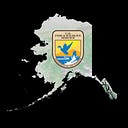Unraveling the Mystery of Pike in Alaska’s Vogel Lake
The case started when Northern Pike (a fish that’s found naturally north of the Alaska Range but is considered invasive south of it) were discovered by the Alaska Department of Fish and Game in Vogel Lake within the Kenai Peninsula’s Miller Creek watershed. Other known pike infestations on the Kenai had already been removed, but the Vogel Lake infestation was the first to be located mostly on Kenai National Wildlife Refuge lands.
Since the discovery, an investigation team consisting of ADF&G, the U.S. Fish and Wildlife Service, and the Kenai Watershed Forum formed with the aim of protecting the native fish community by removing Northern Pike from the Miller Creek watershed.
Although a popular sport fish in many places, pike are an invasive species south of the Alaska Mountain Range. U.S. law defines an invasive species as any plant or animal that is both non-native and causes harm. Pike meet both criteria. Not only were pike illegally introduced to the Kenai Peninsula in the 1970’s, but also, they quickly caused (and continue to cause) harm. Piscivorous (fish-eating) pike eat native fish and endanger local fisheries. Juvenile salmon are a preferred meal for pike but they are opportunistic feeders so their menu can also include insects, frogs, small birds, and mammals. Pike can occasionally be cannibalistic too. When the richest fish prey is gone, that can start a cycle where mostly small, stunted pike are left.
Everybody was wondering: “How did pike arrive in Vogel Lake?”
To understand why this was a puzzling question, we need to open the case files on Northern Pike in Alaska. Typically, pike are a freshwater fish that prefer to hide in relatively shallow, weedy, or slow water. Using these conditions as cover, they save their energy until they strike their prey.
The two most likely scenarios: They were illegally introduced or pike from a source population in another part of southcentral Alaska ventured across Cook Inlet. While reports of pike in saltwater are not uncommon in Europe, reports of pike in saltwater are very rare in Cook Inlet. A critical clue in determining where the pike originated came from an otolith (inner ear bone) from one of the fish, which showed traces of a saltwater isotope signature. While at least one of the pike in Vogel Lake likely spent time in saltwater, the origin of the remaining pike is still under investigation, but most are possibly descendants from pike that potentially crossed Cook Inlet.
With the first mystery partially unraveled, another question needed answering: What can be done to protect the native fish community?
If pike were to be left unmanaged in Vogel Lake, the local Rainbow Trout are mathematically predicted to be almost nonexistent in this waterbody by 2030. Additionally, Vogel Lake is interconnected with many other waters. This means that if allowed to remain in Vogel Lake, pike could further spread, and the cycle of harm could continue. These pike could also become a new source for illegal stocking on the Kenai Peninsula.
The case here becomes even more complex when thinking of where the infestation is located. The affected resources stretch across federal, private, and Borough lands. Working with various partners therefore becomes critical for finding a solution to this challenge. Because Vogel Lake and a portion of the Miller Creek Watershed are located within the boundaries of the Kenai National Wildlife Refuge (federal land), a series of processes must happen before any action to address pike can be taken to both protect the land and ensure that the final action chosen is well-informed.
One such process is an Environmental Assessment. It outlines the options a federal agency can take in order to manage a natural resource. For Vogel Lake, these are:
- Take no action and leave Pike in the Miller Creek watershed
- Physical/mechanical removal (netting and containment),
- Chemical removal (low concentrations of Rotenone, a plant-based compound commonly used by fishery managers to affect creatures with gills ), or
- Combination of techniques known as Integrated Pest Management.
Each option contains both pros and cons. Further details on each option can be viewed here: Draft Environmental Assessment — Northern Pike Management in the Miller Creek Watershed on Kenai National Wildlife Refuge.
As a member of the public, you can comment on which of the options is best for managing pike in the Miller Creek watershed. Comments are accepted during the 30-day public comment period starting March 15th. By acting now, you can help protect native fish on the Kenai Peninsula from invasive Northern Pike.
Remember to always check relevant fish regulations to ensure that you are following the law. If you spot Northern Pike anywhere south of the Alaska Range where they are not already known (see Invasive Northern Pike in Southcentral Alaska for all known pike waters), please report your sighting online at the ADF&G Website Invasive Species Reporting Tool or by calling 1–877-INVASIV. Help keep the Kenai Peninsula wild and free of invasive species.
To learn more, check out these resources:
Refuge Notebook: Why northern pike are bad for the Kenai Peninsula
Invasive Pike in Southcentral Alaska
Native v. Invasive Pike: A Tale of Two Ranges
Alaska Invasive Species Partnership Facebook page
Story by Deborah Kornblut (Regional Invasive Species Outreach Coordinator) and Ben Wishnek (South Region Early Detection Rapid Response Project Manager), Fish and Aquatic Conservation Program. Special thanks to our partners for your work and dedication to keeping Alaska wild and free of invasive species.
In Alaska we are shared stewards of world renowned natural resources and our nation’s last true wild places. Our hope is that each generation has the opportunity to live with, live from, discover and enjoy the wildness of this awe-inspiring land and the people who love and depend on it.
Follow us: Facebook Twitter fws.gov/alaska/
